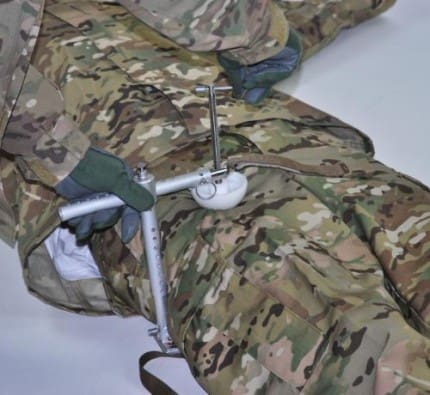Approximately 25% of potentially survivable deaths are due to uncontrolled bleeding at the joints, most of which is attributed to pelvic hemorrhage. The Combat Ready Clamp (CRoC) is a slip-proof expandable aluminum clamp tourniquet that works like a vise to maintain pressure on difficult bleeds when hemorrhage control in tactical environments is not possible with traditional methods and standard tourniquets.
The CRoC already has 510k clearance by the US FDA, and received a recommendation by the Committee on Tactical Combat Casualty Care (CoTCCC).
The full line of Combat Medical Systems gear is available for agency purchase from ADS.
Tags: ADS Inc, Combat Medical Systems



in the aid station hell yeah but on the line i’ll stick to my CAT or SOFTT
The CRoC is for high groin wounds/inguinal bleeds ABOVE where you can place a standard tourniquet.
In other words, if a tourniquet will not fit because there is no limb, that could help. Interesting to see if that does the trick for someone somewhere.
Interesting concept. If, as mentioned, this device is for use when there is no way to apply a TQ why go for a ball end and not a short flat bar?
In the heat of the moment, with claret squirting everywhere, it’s going to be tricky finding the femoral artery. In this situation restricting blood all blood flow won’t be an issue as there will most likely be no limb to save.
There is also the issue of reducing any pelvic fracture which needs to be considered in major trauma. How does the device work in conjunction with a dedicated pelvic splint or improvised splint? With this device in place it would be almost impossible to reduce a pelvic fracture and could compound any internal injuries and internal bleeding. Something the medic would need to consider if inguinal bleeding was present.
Just some thoughts from someone who’s spent some time doing this type of work.
And that’s when my kerlix and ace wraps come into play
This is the same type of device used to stop hemorrhage after an angioplasty. It is designed to put point-specific pressure on the femoral artery which is used to access the aorta and then the blocked coronary artery. I could see this device working relatively well for penetrating inguinal/pelvis injuries with otherwise uncontrollable hemorrhage.
I don’t see why pelvic splinting/stabilization could not be achieved while using this device. The SAM Pelvic splint, or an improvised splint, could be used in conjunction with the CRoC.
If it saves a guy, it’s great stuff.
Tactical Combat Casualty…
[…] fracture and could compound any internal injuries and internal bleeding. Someth […]…
I could see using a “poncho-diaper” to stabilize for a shattered or crushed pelvis or holding it all together from a transpelvic GSW and then using this over\through the “pd’ to clamp down on the FA. I would like to see a flat bar on there as well. Maybe the material can’t support that working load spread out over that much surface area?